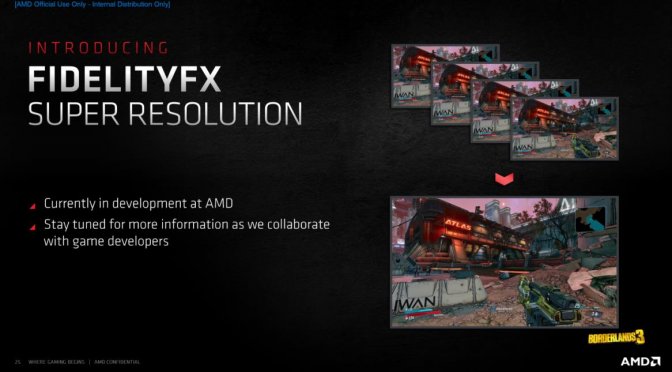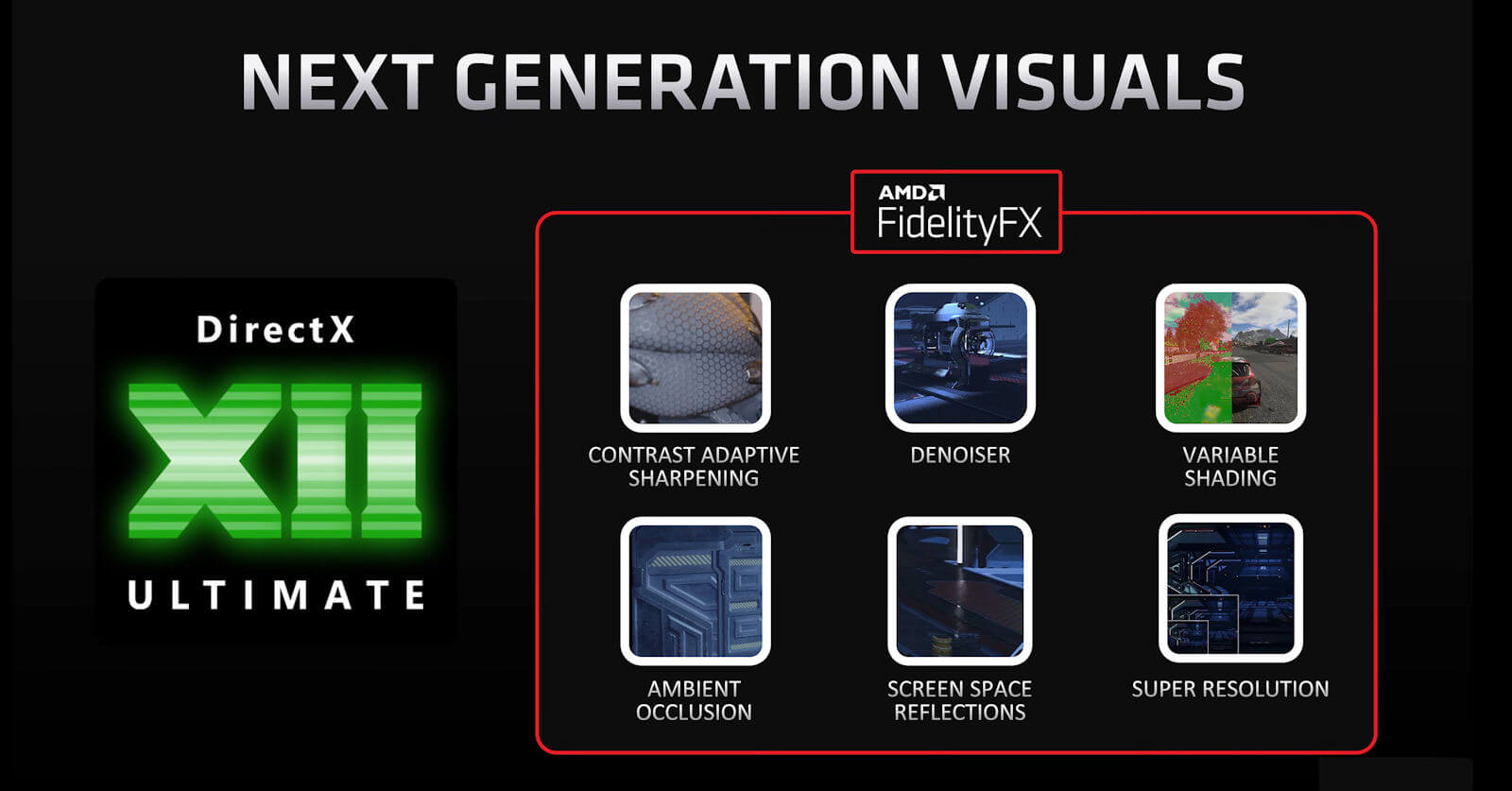We have already heard rumors that AMD is expected to launch its answer to NVIDIA’s Deep Learning Super Sampling technology, dubbed as FidelityFX Super Resolution, sometime later this year. Now in a recent “Full Nerd” PCWorld podcast, AMD’s VP & General Manager Graphics Business Unit Scott Herkelman assured that AMD’s Super Resolution technology is planned to launch this year.
According to AMD this FSR tech feature is progressing well, but they still have more work to do, not only internally, but with game developer partners as well.
“It’s progressing very well internally in our lab, but it’s our commitment to the gaming community that it needs to be open that it needs to work across all things and game developers need to adopt it. Even though it’s progressing well, we still have more work to do and not only internally but with our game developer partners.
We want to launch it this year. We believe we can do that this year, but at the same time we a lot more work ahead of us. We need to make sure the image quality is there. We need to make sure it can scale from different resolutions. And at the same time that our game developers are happy with what we are producing”. —Scott Herkelman.
The official acronym which AMD is using for this super resolution tech is FSR.
“The FSR (that will be called the acronym), is something key to us to launch this year, but it’s gonna take a little bit more time. We are progressing well, but we still have some work to do”. —Scott Herkelman.
Scott further explains that they don’t need machine learning to implement this feature. There are many different ways by which this can be done, and the company is evaluating many different ways to bring this FSR tech feature to fruition.
AMD is going to work with developers and the gaming community to figure out which approach would be the best. We already know AMD’s RDNA GPUs do not have similar specialized hardware Tensor cores, unlike Nvidia Turing and Ampere GPUs, so this doesn’t come as a surprise.
NVIDIA’s DLSS relies solely on AI-based machine learning which is powered by their Tensor core GPU architecture while AMD seems to go with Microsoft’s DirectML approach, which could be run off standard hardware and not any specialized AI core.
AMD has previously hinted that its super resolution tech could be based on Microsoft DirectML API, but at the same time AMD also revealed that this feature would launch as a part of the FidelityFX technology suit.
“You don’t need machine learning to do it, you can do this many different ways and we are evaluating many different ways. What matters the most to us is what game developers want to use because if at the end of the day it is just for us, we force people to do it, it is not a good outcome. We would rather say: gaming community, which one of these techniques would you rather see us implement so that this way it can be immediately spread across the industry and hopefully cross-platform”.— Scott Herkelman.
AMD’s current priority is to launch FSR for PCs first, and Scott confirmed that this technology will be coming first to gaming PCs with Radeon RX GPUs, but will later be extended to other platforms such as gaming consoles which are also powered by the RDNA 2 architecture.
According to one source, FidelityFX Super Resolution will not be part of the graphics driver, and will leverage the DirectML Software API to try to compete with Nvidia’s DLSS to deliver a noticeable performance improvement without deteriorating the visual quality.
The source further mentions that Infinity Cache would also be beneficial for the FidelityFX Super Resolution tech to work properly.
In this old interview/podcast with Scott Herkelman and Frank Azor, AMD emphasized that their version of resolution upscaling and anti-aliasing will be an open-source API and a multi-platform technology.
AMD wants to make this technique fully open source, using a non-proprietary API. This will give the game developers an easy way to implement this tech in games, when it is ready.
This feature is going to be a simple plug and play, having a single unique code. So basically AMD does not plan to code for a specific piece of hardware or a particular game. Secondly, it is going to be multi-platform, and AMD plans to bring this feature to work on the new RDNA2-powered consoles, and AMD graphics cards, as well as on Intel and Nvidia GPUs.
One of the major issues with DLSS is that it’s kind of locked into Nvidia RTX GPUs and APIs. But we still don’t know how AMD’s FidelityFX Super Resolution technology is going to work, and how will it improve the overall Image quality, as compared to DLSS. AMD’s Super Resolution needs to work on all platforms, so it won’t make sense for the company to lock this feature.
The ubiquity of DirectX also suggests that AMD’s FidelityFX Super Resolution tech could have a much higher adoption rate than DLSS.
It also appears that AMD’s FidelityFX likely won’t just be a resolution upsampling either. When AMD announced the RX 6000-series GPUs, the company said that it was working with game developers to implement a number of features like Ambient Occlusion, Variable Shading, and Contrast Adaptive Sharpening.
Some of these features are already available in games like World of Warcraft: Shadowlands and Horizon: Zero Dawn.
With FidelityFX, AMD plans to make their cards much more competitive against Nvidia RTX series graphics cards. But how much they’ll cut into Nvidia’s advantage, still remains to be seen.
If AMD can give its RDNA-based GPUs the same upscaling technique, then team red will have a chance to cut into Nvidia’s market share.
If AMD can develop its FidelityFX Super Resolution technique well enough, it may just be able to give Nvidia a run for its money. But of course, we’ll have to wait and find out.
Source: Videocardz
Hello, my name is NICK Richardson. I’m an avid PC and tech fan since the good old days of RIVA TNT2, and 3DFX interactive “Voodoo” gaming cards. I love playing mostly First-person shooters, and I’m a die-hard fan of this FPS genre, since the good ‘old Doom and Wolfenstein days.
MUSIC has always been my passion/roots, but I started gaming “casually” when I was young on Nvidia’s GeForce3 series of cards. I’m by no means an avid or a hardcore gamer though, but I just love stuff related to the PC, Games, and technology in general. I’ve been involved with many indie Metal bands worldwide, and have helped them promote their albums in record labels. I’m a very broad-minded down to earth guy. MUSIC is my inner expression, and soul.
Contact: Email


